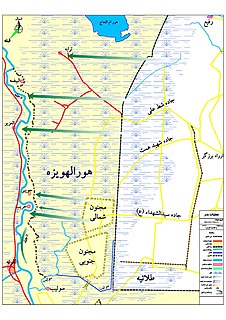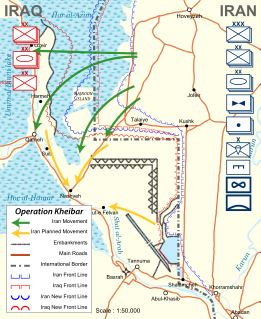
The Iran–Iraq War was a protracted armed conflict that began on 22 September 1980 with a full-scale invasion of Iran by neighbouring Iraq. The war lasted for almost eight years, and ended in a stalemate on 20 August 1988, when Iran accepted Resolution 598 of the United Nations Security Council. Iraq's primary rationale for the invasion was to cripple Iran and prevent Ruhollah Khomeini from exporting the 1979 Iranian Revolution movement to Shia-majority Iraq and internally exploit religious tensions that would threaten the Sunni-dominated Ba'athist leadership. Iraq also wished to replace Iran as the dominant state in the Persian Gulf, which, prior to the Iranian Revolution, was not seen as an achievable objective by the Iraqi leadership due to pre-revolutionary Iran's colossal economic and military power as well as its close alliances with the United States, a superpower, and Israel, a major player in the Middle East. The war followed a long-running history of bilateral border disputes between the two states, as a result of which Iraq planned to retake the eastern bank of the Shatt al-Arab ceded in 1975. Iraq supported Khuzestan Arab separatists seeking an Arab state known as "Arabistan" who had started an insurgency in 1979 with support from Iraq. Saddam Hussein in November 1980 publicly stated that Iraq did not intend to annex Khuzestan Province; rather, it is believed that Iraq sought to establish a suzerainty over the territory.

The Gulf War was a war waged by coalition forces from 35 nations led by the United States against Iraq in response to Iraq's invasion and annexation of Kuwait arising from oil pricing and production disputes.

The United States Central Command is one of the eleven unified combatant commands of the U.S. Department of Defense. It was established in 1983, taking over the previous responsibilities of the Rapid Deployment Joint Task Force (RDJTF).

The Second Battle of Fallujah—code-named Operation Al-Fajr and Operation Phantom Fury—was a joint American, Iraqi-government, and British offensive in November and December 2004, the highest point of conflict during the Iraq War. It was led by the U.S. Marines against the Iraqi insurgents in the city of Fallujah, and was authorized by the U.S.-appointed Iraqi Interim Government. The U.S. military called it "some of the heaviest urban combat U.S. Marines have been involved in since the Battle of Huế City in Vietnam in 1968."
During Operation Iraqi Freedom, Operation Planet X was a US Army mechanized raid conducted on a village near Ad Dawr and Al Dur, 11 miles (18 km) north of Tikrit on the night of 15 May 2003 by elements of the 1st Brigade Combat Team, U.S. 4th Infantry Division and Task Force Ironhorse in search of Ba'ath party members and militants.

Operation Bayonet Lightning was a military operation during the early stages of the Iraq War, that was held to capture weapons, materials, and people who posed a threat against coalition forces. The joint operation between Iraq and the United States, lasted approximately 16 hours, and was conducted on 2 December 2003. 1,200 soldiers from the 173rd Airborne Brigade, the 4th Infantry Division, and Iraqi military participated. Operation Bayonet Lightning was concentrated on Al Hawija, Iraq, and the village of Rashad, Iraq, sixty kilometers, or thirty-seven miles, to the south of Kirkuk, Iraq.
During the Post-invasion of Iraq, Operation Plymouth Rock was a major anti-insurgent sweep of an area south of Baghdad launched on 23 November 2004. Iraqi, American and British troops took part. Elements of the American 24th Marine Expeditionary Unit and the British Black Watch Regiment took part.

After the handover of sovereignty, Operation New Market was a sweep of an area near Haditha in western Iraq conducted by one thousand coalition and Iraqi Security Forces to rid the Euphrates river bank of anti-coalition forces. It was launched on 24 May 2005 and followed Operation Squeeze Play. New Market was followed by Operation Lightning. The operation was named after the famous US Civil War battle at New Market, VA where cadets from the Virginia Military Institute fought and some perished.
Operation Dagger was a 2005 operation of the Iraq War. It took place in the southern Lake Tharthar region, in Al Anbar province and was conducted by the Regimental Combat Team-8, 2nd Marine Division.

The Iraq War was a protracted armed conflict from 2003 to 2011 that began with the invasion of Iraq by the United States–led coalition which overthrew the Iraqi government of Saddam Hussein. The conflict continued for much of the next decade as an insurgency emerged to oppose the coalition forces and the post-invasion Iraqi government. An estimated 151,000 to 1,033,000 Iraqis died in the first three to five years of conflict. US troops were officially withdrawn in 2011. The United States became re-involved in 2014 at the head of a new coalition; the insurgency and many dimensions of the armed conflict continue. The invasion occurred as part of the George W. Bush administration's War on Terror following the September 11 attacks despite no connection of the latter to Iraq.
Operation Sinbad was an operation led by the Iraqi Security Forces and supported by British, Danish and other Multi-National Forces in southern Iraq. The operation began during the early hours of 27 September 2006. The stated goal of the operation was to root out corrupt police as well as offer assistance to the residents of the area in rebuilding. An estimated 2,300 Iraqi army troops and 1,000 British soldiers took part in the operations with another 2,000 in close proximity, in preparation for handing over security of the city of Basra to the Iraqi government.

Raymond Thomas Odierno was an American military officer who served as a four-star general of the United States Army and as the 38th chief of staff of the Army. Prior to his service as chief of staff, Odierno commanded United States Joint Forces Command from October 2010 until its disestablishment in August 2011. He served as Commanding General, United States Forces – Iraq and its predecessor, Multi-National Force – Iraq, from September 2008 through September 2010.

Islamic State, at times known as the Islamic State of Iraq and the Levant, and as the Islamic State of Iraq and Syria, or by its Arabic acronym, Daesh, is a militant Sunni Islamist group and former unrecognized quasi-state that follows a Salafi jihadist doctrine. Islamic State was founded by Abu Musab al-Zarqawi and gained global prominence in 2014 when it drove Iraqi security forces out of key cities in its Western Iraq offensive, followed by its capture of Mosul and the Sinjar massacre.

Shaibah is the name of a small village and a site of a military airfield near Az Zubayr, 7 miles (11 km) south west of Basrah in Iraq. The area was the site of a battle with Turkish Forces during the Mesopotamian campaign of the First World War.
Operation Dawn 3 or Operation Valfajr-3 was an operation during Iran-Iraq war which was commenced on 3 August 1983 at 23 o'clock with the operation code of "Ya Allah". This operation was launched in the range of "semi-extensive operation" located in the general area of Mehran ; and eventually led in the liberation of Mehran by Iranian forces. Iran's goals of the operation were as follows:

Operation Badr was an Iranian operation conducted during the Iran–Iraq War against the forces of Ba'athist Iraq. The Iranians launched their offensive on March 11 and succeeded in capturing a part of the Basra-Amarah-Baghdad highway. The following Iraqi counterattack, however, forced the Iranians out in a continual war of endless stalemate.

Operation Kheibar was an Iranian offensive in the Iran–Iraq War. It was part of the Battle of the Marshes.
Operation Saber Guardian was a joint operation between 3rd Battalion, 3rd Brigade, 5th Iraqi Army soldiers, local concerned citizens, and 6-9 Armored Reconnaissance Squadron, 3rd Brigade Combat Team, 1st Cavalry Division. The operation, targeted at al-Qaida leadership near the town of Sherween, Iraq, resulted in 20 al-Qaida terrorists killed, 20 detained, and two weapons caches and 12 improvised explosive devices discovered.

Operation Phantom Strike was a major offensive launched by the Multi-National Corps - Iraq on 15 August 2007 in a crackdown to disrupt both the al-Qaeda-affiliated Islamic State of Iraq and Shia insurgent operations in Iraq. It consisted of a number of simultaneous operations throughout Iraq focused on pursuing remaining ISI terrorists and Iranian-supported insurgent groups. It was concluded in January 2008 and followed up with Operation Phantom Phoenix.

Operation Guardian Tiger IV was an operation conducted by Marines from the 3rd Battalion, 3rd Marine Regiment and Iraqi Police in the Haditha Triad area in 2006. The operation was focused on conducting a census in the Baghdadi area with the goal of capturing terrorists and building up local police forces. Only a handful of Marines accompanied the Iraqis.













